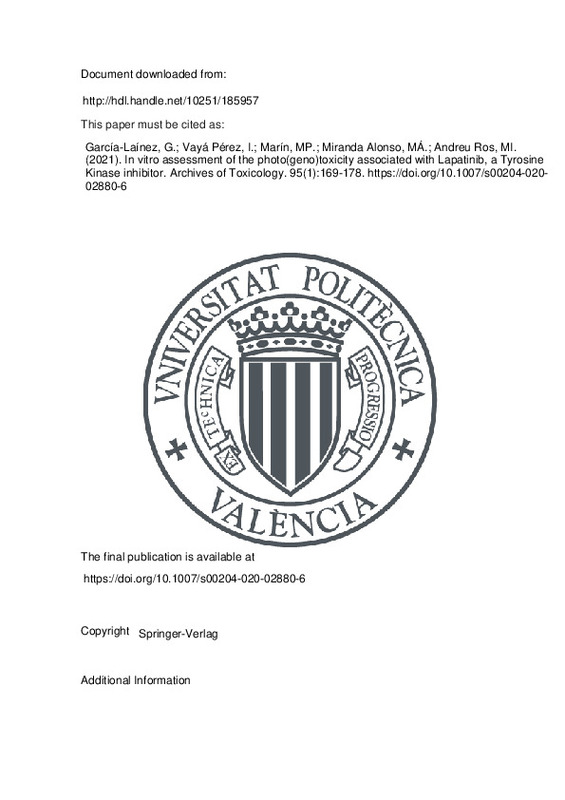Abo-Zeid MAM, Abo-Elfadl MT, Gamal-Eldeen AM (2019) Evaluation of lapatinib cytotoxicity and genotoxicity on MDA-MB-231 breast cancer cell line. Environ Toxicol Pharmacol 71:103207. https://doi.org/10.1016/j.etap.2019.103207
Agundez JAG, Garcia-Martin E, Garcia-Lainez G, Miranda MA, Andreu I (2020) Photomutagenicity of chlorpromazine and its N-demethylated metabolites assessed by NGS. Sci Rep 10(1):6879. https://doi.org/10.1038/s41598-020-63651-y
Cadet J, Davies KJA (2017) Oxidative DNA damage and repair: an introduction. Free Radic Biol Med 107:2–12. https://doi.org/10.1016/j.freeradbiomed.2017.03.030
[+]
Abo-Zeid MAM, Abo-Elfadl MT, Gamal-Eldeen AM (2019) Evaluation of lapatinib cytotoxicity and genotoxicity on MDA-MB-231 breast cancer cell line. Environ Toxicol Pharmacol 71:103207. https://doi.org/10.1016/j.etap.2019.103207
Agundez JAG, Garcia-Martin E, Garcia-Lainez G, Miranda MA, Andreu I (2020) Photomutagenicity of chlorpromazine and its N-demethylated metabolites assessed by NGS. Sci Rep 10(1):6879. https://doi.org/10.1038/s41598-020-63651-y
Cadet J, Davies KJA (2017) Oxidative DNA damage and repair: an introduction. Free Radic Biol Med 107:2–12. https://doi.org/10.1016/j.freeradbiomed.2017.03.030
Castellino S, O'Mara M, Koch K, Borts DJ, Bowers GD, MacLauchlin C (2012) Human metabolism of lapatinib, a dual kinase inhibitor: implications for hepatotoxicity. Drug Metab Dispos 40(1):139–150. https://doi.org/10.1124/dmd.111.040949
Ding J, Yao Y, Huang G et al (2020) Targeting the EphB4 receptor tyrosine kinase sensitizes HER2-positive breast cancer cells to Lapatinib. Cancer Lett 475:53–64. https://doi.org/10.1016/j.canlet.2020.01.032
Ferlay J, Soerjomataram I, Dikshit R et al (2015) Cancer incidence and mortality worldwide: sources, methods and major patterns in GLOBOCAN 2012. Int J Cancer 136(5):E359–E386. https://doi.org/10.1002/ijc.29210
Frenel JS, Bourbouloux E, Berton-Rigaud D, Sadot-Lebouvier S, Zanetti A, Campone M (2009) Lapatinib in metastatic breast cancer. Womens Health (Lond) 5(6):603–612. https://doi.org/10.2217/whe.09.54
Garcia-Lainez G, Martinez-Reig AM, Limones-Herrero D, Consuelo Jimenez M, Miranda MA, Andreu I (2018) Photo(geno)toxicity changes associated with hydroxylation of the aromatic chromophores during diclofenac metabolism. Toxicol Appl Pharmacol 341:51–55. https://doi.org/10.1016/j.taap.2018.01.005
Gavilá J, De La Haba J, Bermejo B et al (2020) A retrospective, multicenter study of the efficacy of lapatinib plus trastuzumab in HER2-positive metastatic breast cancer patients previously treated with trastuzumab, lapatinib, or both: the Trastyvere study. Clin Transl Oncol 22(3):420–428. https://doi.org/10.1007/s12094-019-02145-4
Geyer CE, Forster J, Lindquist D et al (2006) Lapatinib plus capecitabine for HER2-positive advanced breast cancer. N Engl J Med 355(26):2733–2743. https://doi.org/10.1056/NEJMoa064320
Gomez HL, Doval DC, Chavez MA et al (2008) Efficacy and safety of lapatinib as first-line therapy for ErbB2-amplified locally advanced or metastatic breast cancer. J Clin Oncol 26(18):2999–3005. https://doi.org/10.1200/JCO.2007.14.0590
Heppt MV, Clanner-Engelshofen BM, Marsela E et al (2020) Comparative analysis of the phototoxicity induced by BRAF inhibitors and alleviation through antioxidants. Photodermatol Photoimmunol Photomed 36(2):126–134. https://doi.org/10.1111/phpp.12520
Higa GM, Abraham J (2007) Lapatinib in the treatment of breast cancer. Expert Rev Anticancer Ther 7(9):1183–1192. https://doi.org/10.1586/14737140.7.9.1183
Huijberts S, van Geel R, van Brummelen EMJ et al (2020) Phase I study of lapatinib plus trametinib in patients with KRAS-mutant colorectal, non-small cell lung, and pancreatic cancer. Cancer Chemother Pharmacol 85(5):917–930. https://doi.org/10.1007/s00280-020-04066-4
Kabir MZ, Mukarram AK, Mohamad SB, Alias Z, Tayyab S (2016) Characterization of the binding of an anticancer drug, lapatinib to human serum albumin. J Photochem Photobiol B 160:229–239. https://doi.org/10.1016/j.jphotobiol.2016.04.005
Kopper L (2008) Lapatinib: a sword with two edges. Pathol Oncol Res 14(1):1–8. https://doi.org/10.1007/s12253-008-9018-z
Macdonald JB, Macdonald B, Golitz LE, LoRusso P, Sekulic A (2015) Cutaneous adverse effects of targeted therapies: Part I: Inhibitors of the cellular membrane. J Am Acad Dermatol 72(2):203–218. https://doi.org/10.1016/j.jaad.2014.07.032
Medina PJ, Goodin S (2008) Lapatinib: a dual inhibitor of human epidermal growth factor receptor tyrosine kinases. Clin Ther 30(8):1426–1447. https://doi.org/10.1016/j.clinthera.2008.08.008
Melhuish WH (1961) Quantum efficiencies of fluorescence of organic substances: effect of solvent and concentration of the fluorescent solute. J Phys Chem 65(2):229–235. https://doi.org/10.1021/j100820a009
Mendelsohn J, Baselga J (2000) The EGF receptor family as targets for cancer therapy. Oncogene 19(56):6550–6565. https://doi.org/10.1038/sj.onc.1204082
Moon JY, Han JM, Seo I, Gwak HS (2019) Risk factors associated with the incidence and time to onset of lapatinib-induced hepatotoxicity. Breast Cancer Res Treat 178(1):239–244. https://doi.org/10.1007/s10549-019-05382-x
Nolting M, Schneider-Merck T, Trepel M (2014) Lapatinib. Recent Results Cancer Res 201:125–143. https://doi.org/10.1007/978-3-642-54490-3_7
OECD (2004) OECD Guidelines for the Testing of Chemicals Test No. 432: In Vitro 3T3 NRU Phototoxicity Test. https://doi.org/10.1787/20745788
Palumbo F, Garcia-Lainez G, Limones-Herrero D et al (2016) Enhanced photo(geno)toxicity of demethylated chlorpromazine metabolites. Toxicol Appl Pharmacol 313:131–137. https://doi.org/10.1016/j.taap.2016.10.024
Parham LR, Briley LP, Li L et al (2016) Comprehensive genome-wide evaluation of lapatinib-induced liver injury yields a single genetic signal centered on known risk allele HLA-DRB1*07:01. Pharmacogenomics J 16(2):180–185. https://doi.org/10.1038/tpj.2015.40
Rayane Mohamed FS, Sidibe J, Bararpour N, Desmeules J, Ausburger M, Daali Y, Thomas A (2018) Detection and identification of reactive drug metabolites leading to idiosyncratic toxicity: lapatinib as a case example. J Drug Metab Toxicol 9(3):1–6. https://doi.org/10.4172/2157-7609.1000242
Schroeder RL, Stevens CL, Sridhar J (2014) Small molecule tyrosine kinase inhibitors of ErbB2/HER2/Neu in the treatment of aggressive breast cancer. Molecules 19(9):15196–15212. https://doi.org/10.3390/molecules190915196
Spector N, Xia W, El-Hariry I, Yarden Y, Bacus S (2007) HER2 therapy. Small molecule HER-2 tyrosine kinase inhibitors. Breast Cancer Res 9(2):205. https://doi.org/10.1186/bcr1652
Spraggs CF, Budde LR, Briley LP et al (2011) HLA-DQA1*02:01 is a major risk factor for lapatinib-induced hepatotoxicity in women with advanced breast cancer. J Clin Oncol 29(6):667–673. https://doi.org/10.1200/jco.2010.31.3197
Tokura Y, Ogai M, Yagi H, Takigawa M (1994) Afloqualone photosensitivity: immunogenicity of afloqualone-photomodified epidermal cells. Photochem Photobiol 60(3):262–267. https://doi.org/10.1111/j.1751-1097.1994.tb05102.x
Towles JK, Clark RN, Wahlin MD, Uttamsingh V, Rettie AE, Jackson KD (2016) Cytochrome P450 3A4 and CYP3A5-catalyzed bioactivation of lapatinib. Drug Metab Dispos 44(10):1584–1597. https://doi.org/10.1124/dmd.116.070839
Wang H (2014) Lapatinib for the treatment of breast cancer in the People’s Republic of China. Onco Targets Ther 7:1367–1373. https://doi.org/10.2147/OTT.S60586
[-]







![[Cerrado]](/themes/UPV/images/candado.png)


